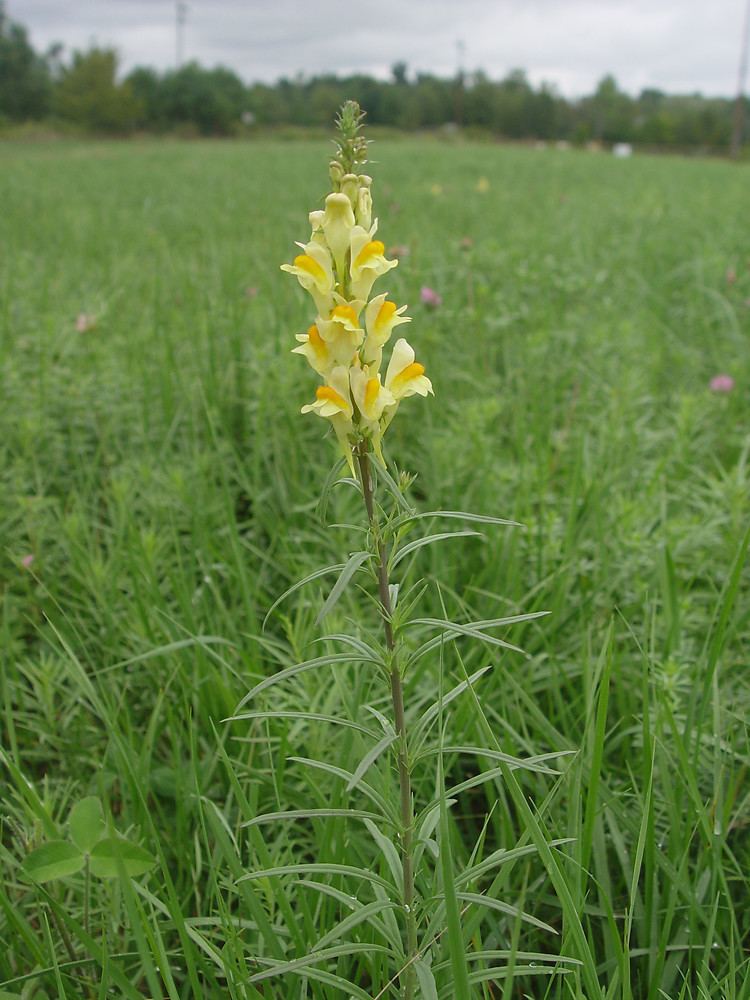Rank Species | Genus Linaria Higher classification Linaria | |
 | ||
Similar Linaria, Galium verum, Galeopsis, Field bindweed, Silverweed Cinquefoil | ||
Linaria vulgaris
Linaria vulgaris (common toadflax, yellow toadflax, or butter-and-eggs) is a species of toadflax (Linaria), native to most of Europe, northern Asia, the United Kingdom, Spain, east to eastern Siberia, and western China. It has also been introduced and is now common in North America.
Contents
- Linaria vulgaris
- Common toadflax linaria vulgaris 2012 09 16
- Growth
- Ecology
- Cultivation and uses
- Other names
- References
Common toadflax linaria vulgaris 2012 09 16
Growth
It is a perennial plant with short spreading roots, erect to decumbent stems 15–90 cm high, with fine, threadlike, glaucous blue-green leaves 2–6 cm long and 1–5 mm broad. The flowers are similar to those of the snapdragon, 25–33 mm long, pale yellow except for the lower tip which is orange, borne in dense terminal racemes from mid summer to mid autumn. The flowers are mostly visited by bumblebees. The fruit is a globose capsule 5–11 mm long and 5–7 mm broad, containing numerous small seeds.
Ecology
The plant is widespread on ruderal spots, along roads, in dunes, and on disturbed and cultivated land.
Because the flower is largely closed by its underlip, pollination requires strong insects such as bees and bumblebees (Bombus species).
The plant is food plant for a large number of insects such as the sweet gale moth (Acronicta euphorbiae), mouse moth (Amphipyra tragopoginis), silver Y (Autographa gamma), Calophasia lunula, gorgone checkerspot (Charidryas gorgone carlota), toadflax pug (Eupithecia linariata), satyr pug (Eupithecia satyrata), Falseuncaria ruficiliana, bog fritillary (Boloria eunomia), Pyrrhia umbra, brown rustic (Rusina ferruginea), and Stenoptilia bipunctidactyla.
Cultivation and uses
While most commonly found as a weed, toadflax is sometimes cultivated for cut flowers, which are long-lasting in the vase. Like snapdragons (Antirrhinum), they are often grown in children's gardens for the "snapping" flowers which can be made to "talk" by squeezing them at the base of the corolla.
The plant requires ample drainage, but is otherwise adaptable to a variety of conditions. It has escaped from cultivation in North America where it is a common naturalised weed of roadsides and poor soils; it is listed as an invasive species in several U.S. states and Canadian provinces.
Despite its reputation as a weed, like the dandelion, this plant has also been used in folk medicine for a variety of ailments. A tea made from the leaves was taken as a laxative and strong diuretic as well as for jaundice, dropsy, and enteritis with drowsiness. For skin diseases and piles, either a leaf tea or an ointment made from the flowers was used. In addition, a tea made in milk instead of water has been used as an insecticide. It is confirmed to have diuretic and fever-reducing properties.
Other names
Linaria acutiloba Fisch. ex Rchb. is a synonym. Because this plant grows as a weed, it has acquired a large number of local colloquial names, including brideweed, bridewort, butter and eggs (but see Lotus corniculatus), butter haycocks, bread and butter, bunny haycocks, bunny mouths, calf's snout, Continental weed, dead men's bones, devil's flax, devil's flower, doggies, dragon bushes, eggs and bacon (but see Lotus corniculatus), eggs and butter, false flax, flaxweed, fluellen (but see Kickxia), gallweed, gallwort, impudent lawyer, Jacob's ladder (but see Polemonium), lion's mouth, monkey flower (but see Mimulus), North American ramsted, rabbit flower, rancid, ransted, snapdragon (but see Antirrhinum), wild flax, wild snapdragon, wild tobacco (but see Nicotiana), yellow rod, yellow toadflax.
